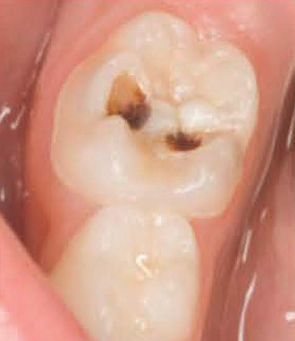
Stainless Steel Crowns: A Stronger Way to Repair Decayed or Underdeveloped Back Teeth
Stainless steel crowns are metal caps made from a combination of stainless steel, nickel, and chrome. These crowns are often used to treat back teeth (molars) that have either decayed or not formed properly due to hypomineralization. They are a more durable option than traditional fillings and offer stronger protection to the tooth.
Pre-made in the shape of the tooth, stainless steel crowns come in a range of sizes. Our dental team selects a crown that will fit over and cover the entire tooth that sits above the gumline.
Crowns can help protect the tooth from further decay and create space in the mouth for adult teeth to grow. Children who need stainless steel crowns typically fall into one of the following categories:





Before

After

Stainless steel crowns have a shiny, silver appearance and are commonly placed on back molars, making them less noticeable than you might expect. Children are often pleased to have a “pirate tooth,” “princess tooth,” “transformer tooth,” “silver cap,” or “hat.”
In general, the crown should remain in place until the baby tooth falls out naturally as the adult tooth erupts. However, in rare cases, the crown may need to be removed or replaced before the tooth falls out.
The procedure for placing a stainless steel crown may or may not require local anesthesia. In some cases, the crown can be slotted over the tooth without extensive decay removal. If the crown does not fit properly, the tooth will be shaped to fit the crown. If nerve/root treatment is required, extensive decay removal and local anesthesia will be necessary before crown placement. Elastic bands are sometimes used to create a small space between the teeth, which allows the crown to be properly seated without shaping the tooth.
After the crown is placed, it should be treated like a normal tooth. Children should brush it twice a day along with their other teeth to maintain proper oral hygiene.
Overall, stainless steel crowns offer a strong and durable solution for repairing decayed or underdeveloped back teeth in children. Talk to your dentist if you think your child might benefit from this treatment.
